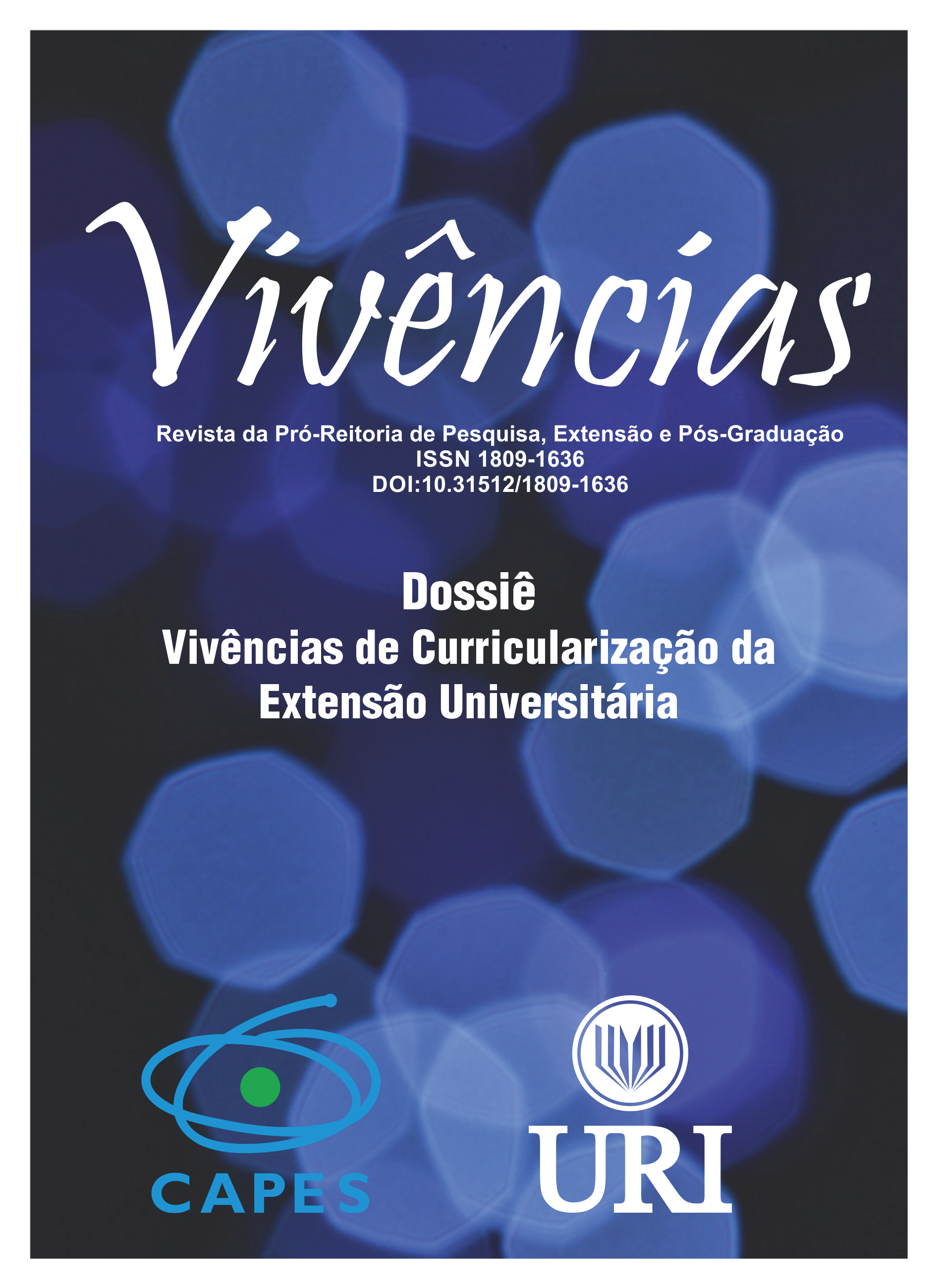PROGRAMA DE EXTENSÃO ON-LINE? RESILIÊNCIA FRENTE AO DISTANCIAMENTO SOCIAL
DOI:
https://doi.org/10.31512/vivencias.v17i34.514Abstract
Devido a pandemia da COVID-19, setores do âmbito educacional foram reorganizados para que suas atividades fossem mantidas mesmo que de forma remota. O mesmo aconteceu com a extensão universitária, um dos pilares que constitui uma universidade. Estudos mostram que plataformas sociais podem ajudar na divulgação científica. Nesse sentido, o objetivo desse trabalho é relatar as estratégias adotadas pelo Grupo de Estudos em Neurociências da Universidade Estadual do Norte do Paraná durante o período de crise. Como estratégia, o projeto de extensão foi transferido para o meio on-line com posts em redes sociais e reuniões por vídeo-chamada. Como resultado, essa estratégia foi eficaz pois houve um aumento de participantes nas reuniões on-line e no grupo no Whatsapp, que já existia previamente, bem como no Alcance e Impressões do Instagram. Conclui-se que essa estratégia atraiu o interesse de mais pessoas, inclusive de fora do meio acadêmico, que é um dos objetivos das ações extramuros.
Riferimenti bibliografici
BARGER, V. A.; LABRECQUE, L. I. An Integrated Marketing Communications Perspective on Social Media Metrics. International Journal of Integrated Marketing Communications, p. 64–76, 2013.
BASILAIA, G.; KVAVADZE, D. Transition to Online Education in Schools during a SARS-CoV-2 Coronavirus Transition to Online Education in Schools during a SARS-CoV-2 Coronavirus (COVID-19) Pandemic in Georgia. Pedagogical Research, v. 5, n. 4, p. 1–9, 2020.
CINELLI, M. et al. The COVID-19 Social Media Infodemic. arXiv preprint arXiv:2003.05004, p. 1–18, 2020. Disponível em: <http://arxiv.org/abs/2003.05004>.
EGHTESADI, M.; FLOREA, A. Facebook, Instagram, Reddit and TikTok: a proposal for health authorities to integrate popular social media platforms in contingency planning amid a global pandemic outbreak. Canadian Journal of Public Health, p. 4–6, 2020.
EKUNI, R. et al. Projeto de Extensão “Grupo de Estudos em Neurociência”: divulgando neurociência e despertando vocações. Revista Brasileira de Extensão Universitária, v. 5, n. 2, p. 55-59, 2014.
FAWCETT, W. J. et al. Education and scientific dissemination during the COVID-19 pandemic. Anaesthesia, 2020. Disponível em: <https://doi.org/10.1111/anae.15185>.
FÓRUM DE PRÓ-REITORES DE EXTENSÃO DAS UNIVERSIDADES PÚBLICAS BRASILEIRAS. FORPROEX. Política Nacional de Extensão Universitária. Manaus: [s.n.]. Disponível em: <https://www.ufmg.br/proex/renex/images/documentos/2012-07-13PoliticaNacional-de-Extensao.pdf>. Acesso em: 13 ago. 2021.
KIETZMANN, J. H. et al. Social media? Get serious! Understanding the functional building blocks of social media. Business Horizons, v. 54, n. 3, p. 241–251, 2011. Disponível em: <http://dx.doi.org/10.1016/j.bushor.2011.01.005>.
KUPFERSCHMIDT, K. The lockdowns worked-but what comes next? Science, v. 368, n. 6488, p. 218–219, 2020.
MELLO-CARPES, P. B. et al. Experiências Vivenciadas na Manutenção do Programa de Extensão Popneuro Durante o Período de Distanciamento Social Imposto Pela Pandemia da COVID-19. Expressa Extensão, v. 26, n. 1, p. 350-361, 2021.
MURALIDHARA, S.; PAUL, M. J. #Healthy Selfies: Exploration of Health Topics on Instagram. JMIR Public Health and Surveillance, v. 4, n. 2, p. 1–12, 2018.
PÉREZ-ESCODA, A. et al. Social Networks ’ Engagement During the COVID-19 Pandemic in Spain : Health Media vs . Healthcare Professionals. International Journal of Environmental Research and Public Health, v. 17, p. 1–17, 2020.
SANTOS, A. G. dos et al. Popnews: divulgando a neurociência através de uma rede social. Rev. Ciênc. Ext., v. 15, n. 4, p. 118–130, 2019.
SEYMOUR-WALSH, A. E. et al. Adapting to a new reality: COVID-19 coronavirus and online education in the health profession. Rural and Remote Health, v. 20, n. 2, p. 1–6, 2020.
THOMAS, R. B.; JOHNSON, P. T.; FISHMAN, E. K. Social Media for Global Education: Pearls and Pitfalls of Using Facebook, Twitter, and Instagram. Journal of the American College of Radiology, v. 15, n. 10, p. 1513–1516, 2018. Disponível em: <https://doi.org/10.1016/j.jacr.2018.01.039>.
WORLD HEALTH ORGANIZATION. Naming the coronavirus disease (COVID-19) and the virus that causes it. Disponível em: <https://www.who.int/emergencies/diseases/novel-coronavirus-2019/technical-guidance/naming-the-coronavirus-disease-(covid-2019)-and-the-virus-that-causes-it>. Acesso em: 4 ago. 2020a.
WORLD HEALTH ORGANIZATION. There is a current outbreak of Coronavirus (COVID-19) disease - Symptoms. Disponível em: <https://www.who.int/health-topics/coronavirus#tab=tab_3>. Acesso em: 4 ago. 2020b.
WORLD HEALTH ORGANIZATION. Coronavirus disease 2019 (COVID-19) Situation Report – 51. 2020c.
WILDER-SMITH, A.; FREEDMAN, D. O. Isolation, quarantine, social distancing and community containment: pivotal role for old-style public health measures in the novel coronavirus (2019-nCoV) outbreak. Journal of Travel Medicine, p. 1–4, 2020.
##submission.downloads##
Pubblicato
Come citare
Fascicolo
Sezione
Licenza

Questo lavoro è fornito con la licenza Creative Commons Attribuzione - Non commerciale - Non opere derivate 4.0 Internazionale.











